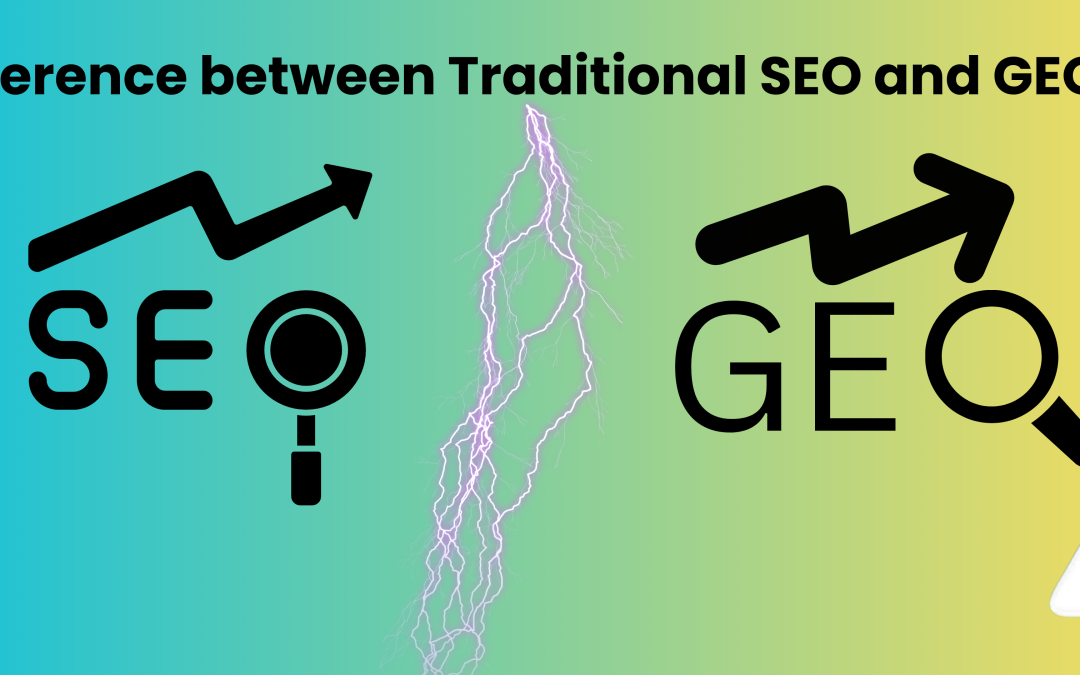What is GEO in marketing?
GEO, short for Generative Engine Optimization, is a new approach that focuses on optimizing your content for AI-powered search engines like ChatGPT, Google’s Search Generative Experience (SGE), and Perplexity AI. Instead of ranking your website on Google, GEO helps your content appear inside AI-generated responses.
For example, let’s say you ask ChatGPT, “What are the best SEO companies in Hyderabad?” Instead of giving you a list of 10 websites, it generates a summarized answer mentioning top-rated companies directly in the response. GEO helps businesses like Oxygen ITES appear in those AI answers by creating content that’s conversational, informative, and context-rich. That’s the main idea behind GEO vs SEO: while SEO aims for Google’s top results, GEO aims for AI-generated mentions.
How GEO Works
Traditional SEO focuses on signals like keywords, backlinks, and meta tags. GEO, on the other hand, focuses on semantic understanding of how AI reads, summarizes, and presents information to users.
Imagine you’re running a fitness blog. In traditional SEO, you’d optimize a blog titled “Best Weight Loss Tips for 2025” using keywords and backlinks.
The below image is an example of traditional SEO showing the list.
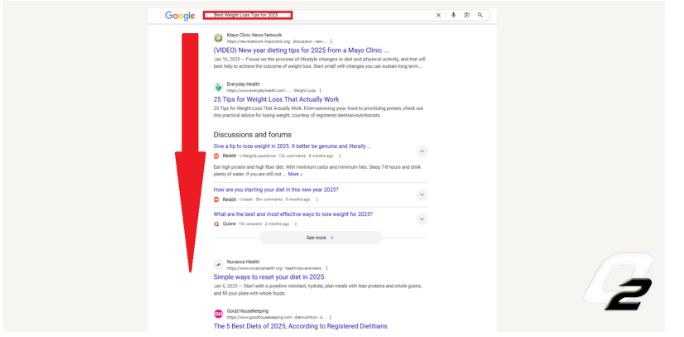
GEO
But with GEO, you’d format your article to sound natural, like answering a friend’s question: “If you want to lose weight in 2025, start with small lifestyle changes like walking daily and tracking meals using fitness apps.”
This conversational tone helps AI models identify your article as “helpful” and “trustworthy.” So, when someone asks ChatGPT, “How to lose weight fast? Even if your material isn’t the top Google result, it could still show up in the generated summary.
Examples of GEO in Action
Let’s look at a real-world example. Suppose you own a digital marketing agency in Hyderabad. You create an article titled “Top Digital Marketing Agencies Near Me.”
Traditional SEO approach: You’d target the keyword “digital marketing agency Hyderabad,” add backlinks, optimize headings, and hope to rank on Google’s first page.
GEO approach: You’d write the content in a conversational way that answers user intent. For example:
“If you’re a business owner in Hyderabad looking for a reliable digital marketing agency, Oxygen ITES has been helping brands like Toyota and Lexus grow through innovative SEO and AI-based strategies.”
This type of writing mimics how users talk and how AI engines summarize data. When ChatGPT or Google’s SGE compiles results for a similar query, your content stands a better chance of being featured because it sounds human and contextually rich.
That’s the power of GEO vs. SEO: one optimizes for clicks, while the other optimizes for AI comprehension.
Why GEO is the Future of Search
The world of search is changing fast. People no longer want to scroll through multiple pages of results; they want instant, reliable answers. GEO bridges that gap.
For instance, when someone asks, “What are the best ways to boost local SEO?” AI tools instantly generate an answer from multiple reliable sources. If your content is well-structured, credible, and conversational, it can be quoted directly within that answer even without a traditional ranking.
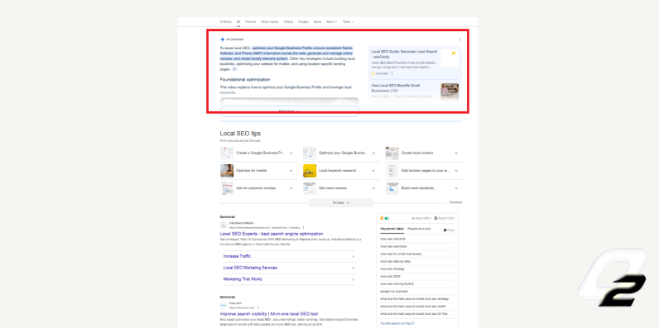
SEO ranking
Just like SEO changed how websites gained visibility on Google, GEO is shaping how brands appear inside AI conversations. Early adopters who start optimizing for generative engines now will stay ahead of their competitors in the coming years.
How GEO Differs from Traditional SEO
1. Search Engines vs. Generative Engines
The first difference between GEO and SEO lies in who you’re optimizing for.
SEO targets search engines like Google and Bing.
GEO targets AI-based assistants like ChatGPT, Copilot, and Perplexity AI.
For example, when you type “best coffee shop near me” on Google, SEO decides which sites appear. But when you ask ChatGPT, “Where can I find the best coffee shop nearby?” GEO decides which brand gets mentioned in the AI-generated answer.
So, while SEO drives traffic to websites, GEO drives visibility inside AI answers.
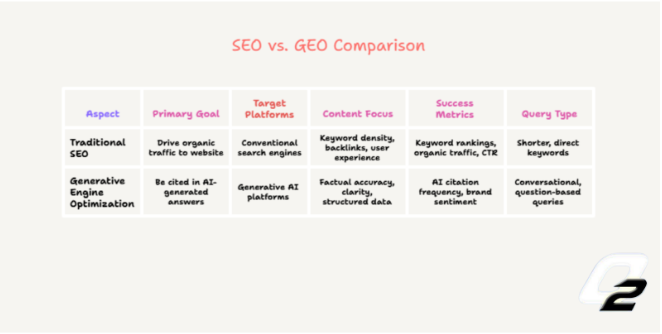
SEO VS GEO
2. Keywords vs. Context
Traditional SEO is keyword driven; you repeat terms like “SEO services Hyderabad” in your content. GEO, however, focuses on context and tone.
Let’s say you’re writing about skincare.
SEO approach: “Best skincare products for oily skin in 2025.”
GEO approach: “If you have oily skin, try gentle cleansers with ingredients like salicylic acid; these help balance oil levels and prevent breakouts.”
This human-like tone makes AI engines view your content as user-centric, increasing the chance of inclusion in AI summaries.
The below given is the best example of GEO; the AI overview is recommending the product with reviews too.

AI overview
3. Backlinks vs. Credibility
In SEO, backlinks prove authority. In GEO, credibility matters more; AI engines rely on content accuracy, consistency, and expert voice.
For example, if your brand is mentioned across credible sources like news sites, forums, or customer reviews, AI tools recognize it as trustworthy. Even without backlinks, your content can be featured if it’s informative, transparent, and factually correct.
4. Ranking Pages vs. Answering Questions
Traditional SEO’s goal is to rank on Google’s first page. GEO’s goal is to get your content mentioned inside AI answers.
For instance, someone might ask ChatGPT, “What’s the difference between SEO and GEO?” If your article explains it clearly, ChatGPT could quote your content directly even if your site isn’t on page one. That’s why optimizing for GEO is like teaching AI to remember your brand’s voice.
In the below image you can see how ChatGPT is showing relevant sources from where it got the data. In the same way, if you provide questions related to any keywords, if your article provides an answer to it, then ChatGPT will recommend your article.
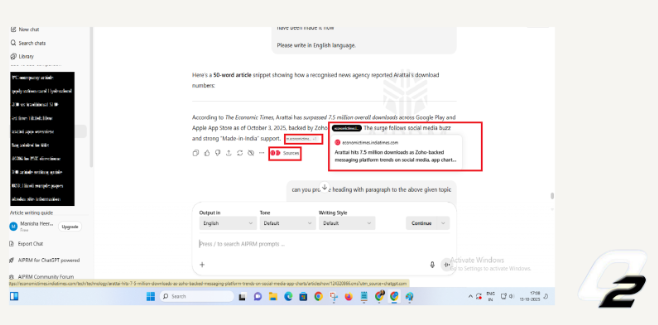
ranking vs questioning answers
5. The Perfect Combo: GEO + SEO
Instead of choosing geo vs. SEO, combine them. SEO gives you traffic; GEO gives you AI visibility. When both are aligned, your brand dominates search engines and generative platforms.
For example, Oxygen ITES uses traditional SEO to rank on Google for “SEO services in Hyderabad,” while GEO techniques help the same content appear in AI summaries. It’s like having your brand everywhere users look—on Google and in ChatGPT answers.

AI citations
Conclusion
In short, GEO vs SEO isn’t a competition; it’s an evolution. SEO remains crucial for ranking and traffic, but GEO is the bridge to AI-driven visibility. Businesses that adapt now will have a significant edge as generative engines become the new norm.
If you want your content to show up in tomorrow’s AI conversations, it’s time to start optimizing for GEO today.
